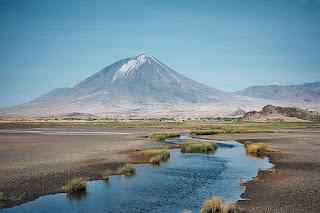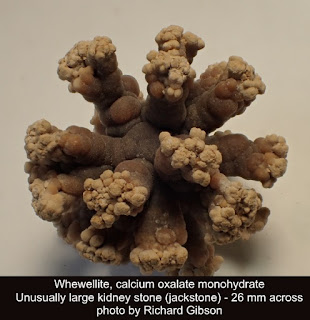Carbonatites are strange igneous rocks made up mostly of
carbonates – common minerals like calcite, calcium carbonate. Igneous rocks
that solidify from molten magma usually are high-temperature rocks containing
lots of silicon which results in lots of quartz, feldspars, micas, and
ferro-magnesian minerals in rocks like granite and basalt. Carbonatites
crystallize from essentially molten calcite, and that’s really unusual.
Most carbonatites are intrusive, meaning they solidified
within the earth, and it wasn’t until 1960 that the first carbonatite volcano
erupted in historic times, proving that they form from cooling magma. The
eruption at Ol Doinyo Lengai in Tanzania occurred on a branch of the East
African Rift System, and most carbonatites are associated with these breaks in
continental crust where eventually a new ocean may form.
 |
| Mt Lengai, Tanzania, photo by Clem23 (Creative Commons License - source) |
A simple and early interpretation of carbonatites was that
they represented melting of limestone, but geochemical data indicate that they
really do come from primary igneous material that probably originated in the
mantle. Exactly how they form is debated, in part because they are so rare, but
one idea is that they result from special cases of differentiation within more
common magmas, or maybe an example of certain chemicals – the carbonates – separating
out in an unusual way.
Another unusual aspect of carbonatites is the minerals
associated with the dominant calcite. It’s common to get rare-earth compounds,
tantalum, thorium, titanium, and many other minerals that are unusual in high
concentrations in other settings. The Mountain Pass rare-earth deposit in
California, once the largest producer of rare earths in the world, is in a
Precambrian carbonatite. Rare earths are used in lots of modern technologies,
including turbines for wind energy, batteries in electric car motors, cell
phones, solar cells, and eyeglasses.
Rare earths are also produced from the Mt. Weld carbonatite
in Western Australia, but it’s more famous for its tantalum, an element that’s
vital in capacitors for cell phones, video games, and computers. Australia has
by far the greatest reserves of tantalum, but mining didn’t begin until 2011
and production is just now ramping up. The United States, which is 100%
dependent on imports for tantalum, imports most of it from Brazil, Rwanda,
China, and Kazakhstan.
Magnetite is a common associated mineral in carbonatites,
and at Magnet Cove, Arkansas, there’s enough to give the name to the place. It’s
also rich in titanium, often in the form of the mineral rutile, titanium dioxide.
When I was there on a geology field trip in 1969, I remember walking into the
Kimzey Calcite Quarry. It was like walking into a giant calcite crystal, with
gigantic cleavage faces the size of a person or bigger. We collected lots of cool
rutile and pyrite crystals.
More common economic minerals can be associated with
carbonatites as well. At one in South Africa the main products are copper and
vermiculite.
While I said earlier that carbonatites are really rare,
there are still a few dozen known. It’s possible that their rarity is a
reflection of the fact that calcite is much more easily eroded and dissolved
than the typical basaltic rocks that derive from most volcanoes, so they may
simply be poorly preserved.
—Richard I. Gibson




